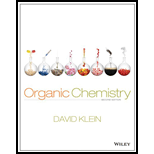
(a)
Interpretation:
To classify the bond present in the given molecules as covalent, polar covalent or ionic.
Concept introduction:
The bonds present in the atoms may be either covalent, ionic and coordination. All these is been decided by the electronegativity difference present in the atoms that share the bonds. If the electronegativity difference between two atoms in the bond is greater than 1.7 means the bond is ionic. If the difference is between 0.5 and 1.7 means the bond is polar covalent. If the difference is lesser than 0.5 means the bond is said to be covalent. The electronegativity value for the atoms is
Sodium = 0.9
Bromine = 2.8
Oxygen = 3.5
Hydrogen = 2.1
Carbon = 2.5
To Classify the bonds present in the given compounds.
(b)
Interpretation:
To classify the bond present in the given molecules as covalent, polar covalent or ionic.
Concept introduction:
The bonds present in the atoms may be either covalent, ionic and coordination. All these is been decided by the electronegativity difference present in the atoms that share the bonds. If the electronegativity difference between two atoms in the bond is greater than 1.7 means the bond is ionic. If the difference is between 0.5 and 1.7 means the bond is polar covalent. If the difference is lesser than 0.5 means the bond is said to be covalent. The electronegativity value for the atoms is
Sodium = 0.9
Bromine = 2.8
Oxygen = 3.5
Hydrogen = 2.1
Carbon = 2.5
To Classify: The bonds present in the given compound
(c)
Interpretation:
To classify the bond present in the given molecules as covalent, polar covalent or ionic.
Concept introduction:
The bonds present in the atoms may be either covalent, ionic and coordination. All these is been decided by the electronegativity difference present in the atoms that share the bonds. If the electronegativity difference between two atoms in the bond is greater than 1.7 means the bond is ionic. If the difference is between 0.5 and 1.7 means the bond is polar covalent. If the difference is lesser than 0.5 means the bond is said to be covalent. The electronegativity value for the atoms is
Sodium = 0.9
Bromine = 2.8
Oxygen = 3.5
Hydrogen = 2.1
Carbon = 2.5
To Classify: The bonds present in the given compounds
(d)
Interpretation:
To classify the bond present in the given molecules as covalent, polar covalent or ionic.
Concept introduction:
The bonds present in the atoms may be either covalent, ionic and coordination. All these is been decided by the electronegativity difference present in the atoms that share the bonds. If the electronegativity difference between two atoms in the bond is greater than 1.7 means the bond is ionic. If the difference is between 0.5 and 1.7 means the bond is polar covalent. If the difference is lesser than 0.5 means the bond is said to be covalent. The electronegativity value for the atoms is
Sodium = 0.9
Bromine = 2.8
Oxygen = 3.5
Hydrogen = 2.1
Carbon = 2.5
To Classify: The bonds present in the given compounds.
(e)
Interpretation:
To classify the bond present in the given molecules as covalent, polar covalent or ionic.
Concept introduction:
The bonds present in the atoms may be either covalent, ionic and coordination. All these is been decided by the electronegativity difference present in the atoms that share the bonds. If the electronegativity difference between two atoms in the bond is greater than 1.7 means the bond is ionic. If the difference is between 0.5 and 1.7 means the bond is polar covalent. If the difference is lesser than 0.5 means the bond is said to be covalent. The electronegativity value for the atoms is
Sodium = 0.9
Bromine = 2.8
Oxygen = 3.5
Hydrogen = 2.1
Carbon = 2.5
To find: To classify the bonds present in the given compound
Want to see the full answer?
Check out a sample textbook solution
Chapter 1 Solutions
Organic Chemistry
 ChemistryChemistryISBN:9781305957404Author:Steven S. Zumdahl, Susan A. Zumdahl, Donald J. DeCostePublisher:Cengage Learning
ChemistryChemistryISBN:9781305957404Author:Steven S. Zumdahl, Susan A. Zumdahl, Donald J. DeCostePublisher:Cengage Learning ChemistryChemistryISBN:9781259911156Author:Raymond Chang Dr., Jason Overby ProfessorPublisher:McGraw-Hill Education
ChemistryChemistryISBN:9781259911156Author:Raymond Chang Dr., Jason Overby ProfessorPublisher:McGraw-Hill Education Principles of Instrumental AnalysisChemistryISBN:9781305577213Author:Douglas A. Skoog, F. James Holler, Stanley R. CrouchPublisher:Cengage Learning
Principles of Instrumental AnalysisChemistryISBN:9781305577213Author:Douglas A. Skoog, F. James Holler, Stanley R. CrouchPublisher:Cengage Learning Organic ChemistryChemistryISBN:9780078021558Author:Janice Gorzynski Smith Dr.Publisher:McGraw-Hill Education
Organic ChemistryChemistryISBN:9780078021558Author:Janice Gorzynski Smith Dr.Publisher:McGraw-Hill Education Chemistry: Principles and ReactionsChemistryISBN:9781305079373Author:William L. Masterton, Cecile N. HurleyPublisher:Cengage Learning
Chemistry: Principles and ReactionsChemistryISBN:9781305079373Author:William L. Masterton, Cecile N. HurleyPublisher:Cengage Learning Elementary Principles of Chemical Processes, Bind...ChemistryISBN:9781118431221Author:Richard M. Felder, Ronald W. Rousseau, Lisa G. BullardPublisher:WILEY
Elementary Principles of Chemical Processes, Bind...ChemistryISBN:9781118431221Author:Richard M. Felder, Ronald W. Rousseau, Lisa G. BullardPublisher:WILEY





